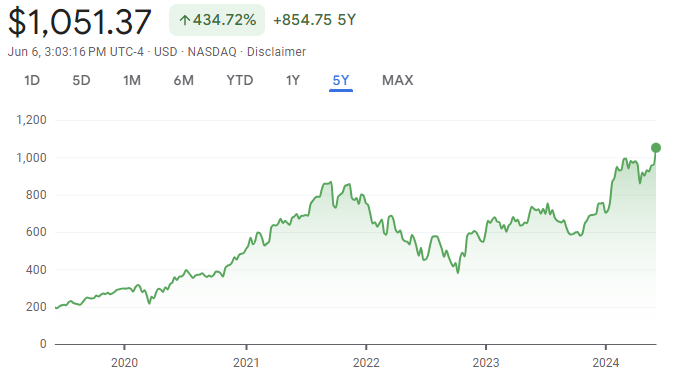ASML looks compelling in June 2024, but is it the right time to buy?
![]() Ujjwal Maheshwari, June 12, 2024
Ujjwal Maheshwari, June 12, 2024
The tech sector is buzzing with excitement and ASML (NASDAQ: ASML) is one company that stands out in the sector. With a history of robust growth and a critical role in the semiconductor industry, this company is on the radar of many investors. But the question remains: Is now the right time to buy?
ASML’s Monopoly Position
ASML is a Dutch company (based in Veldhoven which is on the outskirts of the famous southern city of Eindhoven) that manufactures lithography machines, essential equipment used in the production of semiconductors. The company’s shares are listed both on the Euronext exchange and on New York’s NASDAQ exchange. Lithography machines are critical for making the most advanced chips that power everything from smartphones to artificial intelligence (AI) applications. The company holds a unique monopoly in the market with its extreme ultraviolet (EUV) lithography technology, making it an indispensable player in the semiconductor industry.
These lithography machines are unmatched in the industry and are vital for producing the latest generation of high-performance chips with smaller and more efficient transistors. Companies like Taiwan Semiconductor Manufacturing (TSMC), Intel, and Samsung rely on this EUV lithography technology to stay competitive. This monopoly gives ASML significant pricing power and a wide economic moat, protecting it from potential competitors.
In the first quarter of 2024, ASML reported a gross margin of 51.41% and an operating margin of 26% – impressive for a highly-capital intensive company such as this one. Despite a recent dip in revenue, mainly due to the cyclical nature of its business, the company’s financial health remains strong. Shares have soared over 430% in the last five years, reflecting its dominant market position and the growing demand for advanced semiconductors.

A Look at the Numbers
ASML’s recent financial performance has been mixed. The company’s revenue for Q1 2024 was down 24% year-over-year, coming in at $5.63 billion. Earnings also fell, with EPS dropping from $5.44 in Q1 2023 (which equates to a $2.1bn profit based on 393.4m shares on issue) to $3.31 in Q1 2024 (US$1.3bn). This decline was expected as the company transitions to newer equipment and as chipmakers temporarily reduced their capital expenditures.
However, the long-term outlook still appears promising, and the short-term has done little to dent it. ASML has a substantial order backlog of 38 billion euros, indicating strong future demand. The management expects revenue to rebound in the second half of 2024 and continue growing into 2025. Wall Street analysts project ASML’s earnings per share to rise significantly from $20.75 in 2024 to $32.29 in 2025, roughly translating from a US$8.1bn profit to a US$12.7bn profit. This growth is driven by the increasing demand for advanced chips, fueled by trends in AI, data centers, and high-performance computing.
The AI Boom: A Major Growth Catalyst
One of the most compelling reasons to consider investing in ASML now is the demand for AI technologies. AI applications require powerful and efficient chips, which in turn depend on lithography machines, and this company provides the best lithography machines in the world. As AI continues to expand across various industries, the demand for cutting-edge semiconductors is set to surge.
Lithography machines are non-negotiable for manufacturing AI chips, as it enables the production of high-performance processors with smaller nodes. Nvidia, a leader in AI hardware, uses ASML’s machines to produce its GPUs, which are essential for AI development. The AI market is expected to grow at a staggering annual rate of 36% through 2030, providing a significant tailwind for the company.
Near-Term Challenges
Despite the optimistic long-term outlook, ASML faces some near-term challenges. The semiconductor industry is currently experiencing a down cycle, with reduced spending on new manufacturing equipment. This cyclical downturn has led to a temporary dip in ASML’s revenue and bookings. For example, net bookings in Q1 2024 were 3.6 billion euros, down from 9.2 billion euros in Q4 2023.
However, this slowdown is expected to be temporary. ASML’s management has indicated that 2024 will be a transition year, with a significant rebound anticipated in 2025. The construction of new semiconductor fabrication plants (fabs) globally is expected to drive demand for lithography equipment. Industry association SEMI, the top entity of its kind in the world, projects that 58 new fabs will be built between 2024 and 2030, doubling the spending on semiconductor equipment from $89 billion in 2023 to $176 billion in 2030.
So what are the Long-Term Growth Prospects?
ASML’s strategic positioning in the semiconductor industry is unmatched. The company’s exclusive technology and strong customer relationships position it well to capitalize on the increasing complexity and demand for advanced chips. The transition to smaller nodes and the integration of AI into various applications will drive sustained growth for ASML.
Moreover, ASML’s financial projections indicate robust future growth. The company expects to achieve revenue between 30 billion euros and 40 billion euros by 2025. This growth will be supported by its strong order backlog and the expected increase in equipment orders as new fabs come online. Analysts project that the company’s earnings will grow at an annual rate of 21% over the next five years, potentially driving significant stock price appreciation.
Is it rightly valued now?
ASML’s stock is not cheap, trading at a high price-to-earnings (P/E) ratio of 44 based on current earnings. However, this premium valuation reflects the company’s unique market position and strong growth prospects. If the company meets its projected earnings growth, the P/E ratio would drop significantly, making the stock more attractive.
For instance, if ASML achieves the projected EPS of $55 by 2028, the stock could trade at a more reasonable multiple, potentially around 26 times earnings, given the industry average. This suggests substantial upside potential from current levels. Investors should consider the long-term growth trajectory and the company’s critical role in the semiconductor supply chain when evaluating its valuation.
Alternatively, the P/E ratio would also drop if the share price did, although it is inevitable that the share price wouldn’t start falling for no reason – there would need to be a major earnings miss or perhaps a geopolitical crisis for this to happen. The catch would be that the company would only still be compelling if it was just investors panicking about what might happen, and these worries would be unlikely to impact the company – at least to the magnitude implied.
A Unique Investment Opportunity
Investing in ASML stock right now presents a strategic opportunity for long-term growth. The company’s dominant position in the semiconductor industry, its exclusive EUV lithography technology, and the growing demand for advanced chips driven by AI provide compelling reasons to consider this stock as a valuable addition to your portfolio.
While near-term challenges and cyclical downturns in the semiconductor industry may cause some volatility, the company’s robust backlog and the anticipated increase in equipment orders position it well for a strong recovery. The projected earnings growth and significant market opportunities suggest that now might be an opportune time to invest in ASML stock.
What are the Best Technology Stocks to invest in?
Check our buy/sell tips
Blog Categories
Get Our Top 5 ASX Stocks for FY25
Recent Posts
Cettire shares are down over 90% from their all time high as investors follow the leader in selling shares
It hasn’t been a good 14 months for Cettire shares. For a long time after the pandemic, eCommerce was one…
How will stocks be impacted by tariffs? Here are 6 victims on the ASX and how they’re responding
How will stocks be impacted by tariffs? Its a long story, but few stocks can say that there’ll be no…
The $3m super tax is coming! If you’re invested in equities, here is how it might impact you
It seems during the next 3 years, the $3m super tax will be officially a thing. Itwas blocked by the…



